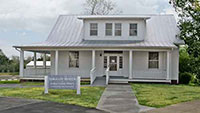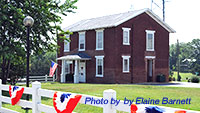Contributing Organizations
Archival Collections on This Site
Several local history societies and museums in Piedmont Virginia are contributing content from their archives to The Land Between the Rivers. Together they provide documentation of the history of the region east of the Blue Ridge Mountains between the James and Rappahannock Rivers. Each society or museum holds in its collections unique objects, photographs, and documents unobtainable elsewhere, yet vital to understanding the history, people, and culture of the region as a whole. Listed below are the museums and historical societies contributing content from their archives at this time. We invite and encourage all those dedicated to preserving history in our region to become contributing members.
The Sargeant Museum of Louisa County History
Home of The Louisa County Historical Society
 We trust the rich history and diverse heritage of Louisa County will come alive as you experience our exhibits at The Sargeant Museum of Louisa County History. The museum opened in 2008 and has displays showcasing Native People, The Revolutionary period, the Civil War, education, transportation, and government. The museum also serves as the orientation center for the Civil War in Louisa County and the Battle of Trevilian Station driving tour.
We trust the rich history and diverse heritage of Louisa County will come alive as you experience our exhibits at The Sargeant Museum of Louisa County History. The museum opened in 2008 and has displays showcasing Native People, The Revolutionary period, the Civil War, education, transportation, and government. The museum also serves as the orientation center for the Civil War in Louisa County and the Battle of Trevilian Station driving tour.
The Louisa County Historical Society has been at work for over 40 years to preserve and protect the rich history of the county. Our courthouse records date back to 1742 and the Society has extensive archival materials documenting local and family history at the Sargeant Museum. If you need research assistance, we welcome you to contact us at louisahistory@verizon.net or visit our website for visitor hours and information.
Exhibits online:
World War II
The Greene County Museum
 Greene is one of the smallest counties in Virginia in both area and population, and the mountainous region of the County forms part of the Shenandoah National Park. The Greene County Historical Society, which was established in 1978, collects, preserves and displays for the public items that illustrate the history of the County.
Greene is one of the smallest counties in Virginia in both area and population, and the mountainous region of the County forms part of the Shenandoah National Park. The Greene County Historical Society, which was established in 1978, collects, preserves and displays for the public items that illustrate the history of the County.
The Society’s Museum is located at 360 Main Street, Stanardsville, Virginia. The Museum, which is staffed by volunteers, is open on Fridays and Saturdays from 10:00 am until 3:00 pm. In addition to changing displays of artifacts, the Society’s genealogical research facilities are housed in the Museum, including a 110,000-name database of descendants of Greene County. Items pertaining to the history of the County, such as marriage and census records, and cemetery records, may be purchased at the Museum.
The Fluvanna County Historical Society
THE OLD STONE JAIL MUSEUM
THE HOLLAND PAGE PLACE 1865 LOG CABIN MUSEUM
THE ARCHIVE COLLECTION located at The Fluvanna County Historical Society – Palmyra
The Old Stone Jail Museum
The early minutes of the County Court indicate that a “sufficient Gaol” was needed. General John Hartwell Cocke of Bremo designed the 1828 building and drew up the specifications. John G. Hughes of Fork Union was hired as the contractor. The structure is a two-over-two Palladian-design building with center entryway. It was considered “ plain and neat” style with fireplaces in the center rooms for the jailer. Cocke designated door frames of bar iron, doors of white oak plant (later covered with metal) and locks of “first quality, not less than $8 each”. The windows are barred with interlaced straps of iron. Today the Society opens and closes the massive door to the jail with the original key, made in 1828. The Jail was used as a site of incarceration until the 1940s. Mrs. Virginia Snead petitioned the County Supervisors for use of the Old Jail as the Society museum in 1964. From that time to the present, visitors and tour groups and school children have entered the jail to learn about the history of Fluvanna County.
In 2003, the Fluvanna Historical Society was able to purchase and restore the last extant building in the village of Palmyra, next to the Old Stone Jail Museum, and began the expansion of the Archive Collection. Today “Maggie’s House” is the headquarters for the growing Society, housing the valued Archive Collection containing thousands of historic documents, letters, photographs and genealogical information for the public to research. Visitors are welcome on Tuesdays and Wednesdays from 1-4:00 or by appointment. See our website for more information or email: fluvannahistory@gmail.com
Holland Page Place 1865 Log Cabin Museum
The Holland Page Place is a post Civil War era log cabin built by John Benjamin Page at the conclusion of the Civil War. The property includes farmland and woods. The remains of the Pace Family Gold Mine borders the property. Mrs. Sara Holland Loving generously donated the property with 8 acres I 1998 to the Society. In 2006, the Society received a grant to restore and rehabilitate the building to its 1865 roots, in an effort to tell the story of agrarian life in Fluvanna. The cabin now represents a true interpretation of life just at the Civil War, with all its hardships and limitations, but with all the beauty of a simply lived life. Tours may be arranged at any time of the year, and group tours are encouraged. The summer brings another enjoyable view of the subsistence garden planted and maintained by the Fluvanna Master Gardeners.
The Fluvanna Historical Society is staffed by many dedicated volunteers, student interns, and an Executive Director. Our mission is to preserve, education and conserve the valuable history of this county. We are devoted to the lessons of history and hope that our guests and visitors will learn from the history saved by our community to share with everyone. We encourage visitors to call or email us to learn more about Fluvanna history and to research their own valuable family history.
Collaborating organizations establish individual collections showcasing selected items. Please browse the Collections to see items by contributing organization.